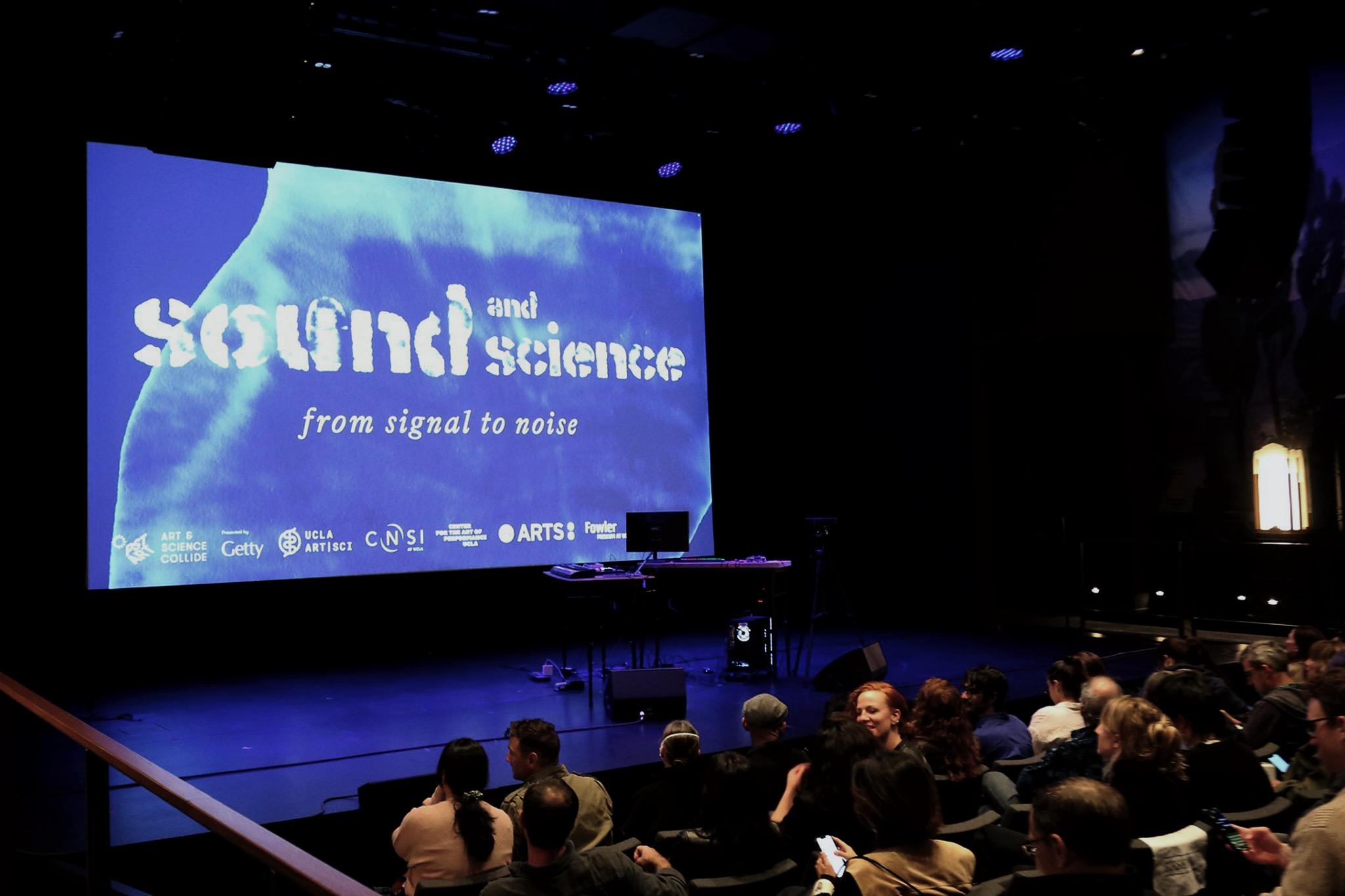
Sound and Science: Exploration of Sonic Arts in a Changing World
On Saturday, March 15, the UCLA Art|Sci Center and UCLA’s Center for the Art of Performance (CAP UCLA) presented Sound and Science: From Signal to Noise at The Nimoy. The sold-out event featured performances by UCLA Arts alumni Iman Person M.F.A. ’22 and Ivana Dama ’21, Department of Design Media Arts Assistant Professor Jenna Caravello, and sound artists Celia Hollander and Paige Emery. Inspired by scientific fields such as physics, biology, and botany, the showcase explored themes deeply intertwined with the artists' activist work, addressing ecological, social, and ancestral issues.
The evening began with sound artist and composer Celia Hollander alongside animator and media artist Jenna Caravello, who together presented Air Shape Index. This audiovisual performance explored the forces—both ecological and societal—that shape the air we breathe. Through a live dialogue between sound and image, Hollander built musical compositions while Caravello used video game software that responded in real-time to her movements. Reflecting on conditions before and after natural catastrophes, their performance served as a meditation on impermanence, collaboration, and the unseen forces shaping our world.
Sound artist and researcher Ivana Dama presented Signal Eclipse, an exploration of the intersection between natural and mechanical alarms. Performing with a custom-built theremin, Dama used the instrument’s electromagnetic field to interact with an analog synthesizer, drawing from her research on air raid sirens and electronic music. This theremin, developed in collaboration with MIT's Center for Bits and Atoms with the support of Neil Gershenfeld and Quentin Bolsee, builds upon their previous research in capacitance sensors and rapid prototyping. At the heart of the performance—and projected behind Dama—were birds, nature’s own alarm signals. Both a warning and a call to action, their flight patterns shaped a shifting sonic landscape. Signal Eclipse oscillated between urgency and silence, prompting reflection on how we perceive alarms and what lingers when the noise fades.
Following Dama was first-generation Jamaican American artist and cultural anthropologist Iman Person, whose work explores Black and Indigenous technologies in relation to ritual, land, language, and cosmic time. Her piece, Echo, invited a return to the source through vibration, intertwining sound and movement to manifest resonance. Rooted in the Bakongo cosmogram—a symbol of cyclical existence in African diasporic traditions—the work dissolved linear time, layering live and recorded elements to create a spectral presence. Choreographed by Wilfried Souly, a lecturer in the Department of World Arts and Cultures/Dance, and performed by Adama Ideozu, Echo bridged ancestral memory and the present, using sound and movement as vessels for communion and transformation.
Artist and herbalist Paige Emery concluded the showcase with a performance that bridged healing arts, critical ecology, and ancestral memory—rooted in reciprocity with nature. Emery presented A Multispecies Choir for the Fertile Earth, a sound installation and performance that shifted focus from human-centered plant communication to the ways sound can benefit plant life. Using elemental instruments—a solar-powered synth (fire), a sonified water fountain (water), wind chimes (air), a gong for soil health (earth), and breath (ether)—Emery collaborated with nature to explore sonic regeneration. In consultation with UCLA botanists, she experimented with frequencies that support plant growth, creating a performance designed as much for plants as for humans.
Sound and Science was an extension of the UCLA Art|Sci Center’s ongoing exhibition, Atmosphere of Sound: Sonic Art in Times of Climate Disruption. Part of Getty’s region-wide initiative PST ART: Art & Science Collide, Atmosphere of Sound continues with Joel Ong’s installation, In Silence…, on view from April 4–25, 2025, at the California NanoSystems Institute’s CNSI Art|Sci Gallery. Curated by Victoria Vesna and Anuradha Vikram, the exhibition merges sound art and science to encourage deep reflection on climate-related issues.